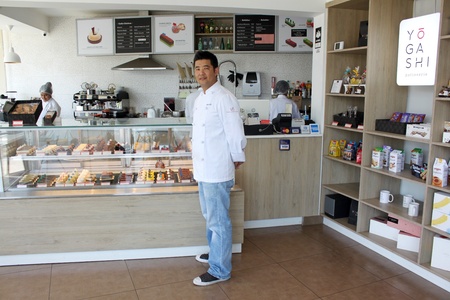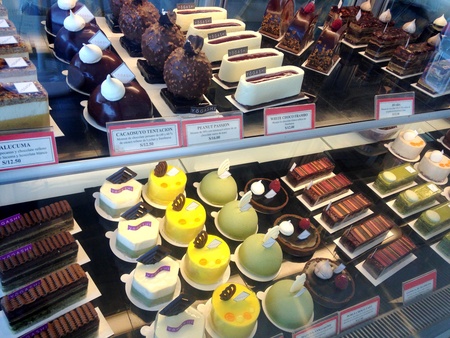There is in Peru, a store whose creations represent three nationalities. At Yogashi Patisserie, in an unnoticed corner of Lima's San Borja district, a Nikkei sums up three countries in one dessert. The story of Carlos Yanahura has a link with French and Japanese pastries that have come to fruition in Peru.
Carlos studied at the Los Andes Institute in the late nineties, years before gastronomy was the calling card of his country and, once graduated, he went to work in restaurants and hotels in the capital. Then he traveled to the United States to continue studying cooking, until he came across a Peruvian restaurant (Inti Peruvian, in California) where he started to work.
His return to Peru was just a way of leaving again. This time his destination was Japan, specifically Nagoya, in 2006, which more than a return to his family's roots seemed like an accidental coincidence: his wife was going to continue postgraduate studies in the country where Carlos would get to know fine French pastries up close. . But at the beginning nothing was easy.
“I couldn't get a job until I started working in a restaurant as a dishwasher.” Carlos says that he was studying Japanese and that he hoped that at some point an opportunity in cooking would present itself. Another restaurant in the same chain gave him the option and for a time he worked both jobs: in one he washed dishes and in the other he helped prepare them. Unknown to him, a sweet future was very close.
Obsessed pastry chef
One day they told him that they were looking for a pastry chef, but Carlos didn't want to leave the kitchen. “I didn't know anything about pastry,” he confesses, a few meters away from a display case with some of his more than forty creations. At Zephyr he learned about French pastry developed in Japan, a country that has added the search for perfection to refined French techniques.
“In French pastry everything is artisanal, all processes are manual and no preservatives are used.” The worldwide fame of its sponge cakes, pastry creams, pâtés, macaroons and frostings needs no further explanation. “That's where my addiction started,” Carlos confesses. He accepted the challenge of this small establishment and continued his cooking training at the Nichie Cooking Collage school, where he was the only foreign student.
Remember that he used a dictionary to be able to follow classes. Since then he has the desire to continue learning. “I'm always training, in the pastry shop you never finish learning, you have to update yourself,” notes Carlos, who later joined the larger Moncher pastry shop (with stores outside the country) and continued studying at Le Cordon Bleu de la Kobe city.
sweet idea

The desserts should not be cloying, each one should be exactly the same as the other and in the display case they should be perfectly aligned. These and other ideas were on the mind of Carlos Yanahura, who in 2012 decided that it was time to return to his country with a project that had been cooking in the oven of his mind.
He visited all the pastry shops in Lima to learn about the local offerings and traveled around Asia looking for the most suitable equipment for his pastry workshop in which he would use top quality supplies even if the price was very high. He began importing ingredients from Japan, such as green tea, and from the United States, such as almond flour, without which he cannot conceive a French dessert.

Yogashi Patisserie began in a workshop in Breña, with no door to the street but which was already beginning to cause interest in the Nikkei neighborhood and among pastry lovers, the foodies. At the end of 2013, an article in Kaikan magazine summarized its proposal in this way: “Yogashi Patisserie offers 55 varieties of cake, covering a wide range of flavors and colors. In his proposal, tradition and fusion coexist” 1 .
Lucuma, cherimoya, soursop, raspberry, among other ingredients, are mixed with chocolates with a high percentage of cocoa (Belgian, Peruvian and Ecuadorian) using French and Japanese techniques. To the desserts, Carlos has added drinks such as matcha latte and a shelf of quality imported products for connoisseurs (cookies, breads and exclusive chocolates).
The store
The minimalism of the desserts, the art of decoration and the confusion caused by their names, practically unknown in Peru, where the popular pastries are the traditional Lima ones, are some factors that differentiate the Yogashi store, inaugurated in September 2015; as well as the use of first-class inputs, such as the expensive Ecuadorian chocolate República del Cacao.
"In the store we work with an open kitchen, our production takes two days for each dessert and we are always changing them." Some of those mentioned by Peruvian food bloggers and journalists are the Matcha anko dome (green tea mousse with biscuit of the same ingredient and Japanese bean paste) and the Asian tropical (mango mousse with passion fruit, filled with lychee gelatin and sponge cake). vanilla).
It has not been easy to deal with an audience unaccustomed to novelty, but Carlos feels satisfied to be able to present a first-class proposal that he has faith in. Thanks to this, it has been able to capture the preference of the Japanese Embassy, events in the Japanese Peruvian colony and regular customers who already recognize the quality of its fine pastries.
Lessons up your sleeve
In a country that in recent years has been recognized as the best culinary destination in the world, the national pastry still seems far from reaching the level of world powers such as France, Belgium and Japan; a goal that should be among the priorities of Peruvian pastry chefs. Carlos knows that the fence is very high, especially due to budgets.
“In world competitions, Italians are sponsored by the most important brands. "The Japanese prepare for an entire year, travel in advance and have all the logistics to transport their supplies." This year, Carlos was in Lyon to watch one of these competitions and continue training, a recommendation he gives to all the members of his team.
Order, perfection and cleanliness are part of the ideology of Yogashi Patisserie, whose recipes continue to multiply. “I always try to be at the forefront,” says someone who continues to experiment but with clear instructions. Perfection shines in a simple phrase: “there are no pinches here, all the recipes are made with a scale,” he says smiling.

Notes:
1. Enrique Higa, “A world of cakes: Yogashi patisserie, between classic and fusion”, Kaikan (No. 82, November 2013), p. 24.
© 2017 Javier Garcia







